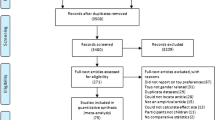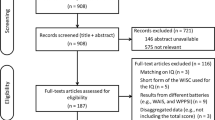Abstract
Various finger length and personality and ability measures were obtained for a sample of Australian adolescent twins (306 boys and 397 girls). A new measure of relative finger length (the length of a given finger relative to the sum of all four fingers) was investigated, and shown to be superior to the traditional 2D:4D for discriminating between the sexes. It also had the advantage of permitting a more analytic approach: for example, the 2nd finger-length contributed much more than the 4th finger length to the sex difference in 2D:4D, and a smooth gradient of sex differences across the hand was evident. Sex differences on right hands were greater than those for left hands. Within-sex correlations were obtained between the various finger-length measures and a personality and an ability scale that showed relatively large sex differences (Eysenck’s Psychoticism scale and the spatial subscale from Jackson’s Multidimensional Aptitude Battery). The correlations were low, but on the whole consistent with the between-sex differences for the girls. For the boys, this was so for Psychoticism, but spatial ability was, if anything, correlated in the opposite direction.
Similar content being viewed by others
References
Bailey, A. A., & Hurd, P. L. (2005). Depression in men is associated with more feminine finger-length ratios. Personality and Individual Differences, 39, 829–836.
Baker, F. (1888). Anthropological notes on the human hand. American Anthropologist, 1, 51–76.
Brown, W. M., Hines, M., Fane, B. A., & Breedlove, S. M. (2002). Masculinized finger-length patterns in human males and females with congenital adrenal hyperplasia. Hormones and Behavior, 42, 380–386.
Buck, J. J., Williams, R. M., Hughes, I. A., & Acerini, C. L. (2003). In-utero androgen exposure and 2nd and 4th digit length ratio—comparisons between healthy controls and females with classical congenital adrenal hyperplasia. Human Reproduction, 18, 976–979.
Burton, L. A., Henninger, D., & Hafetz, J. (2005). Gender differences in relations of mental rotation, verbal fluency, and SAT scores to finger-length ratios as hormonal indexes. Developmental Neuropsychology, 28, 493–505.
Cattrall, F. R., Vollenhoven, B. J., & Weston, G. C. (2005). Anatomical evidence for in utero androgen exposure in women with polycystic ovary syndrome. Fertility and Sterility, 84, 1689–1692.
Cohen, J. (1977). Statistical power analysis for the behavioral sciences (rev. ed.). New York: Academic Press.
Ecker, A. (1875). Einige Bemerkungen über einen schwankenden Charakter in der Hand des Menschen. Archiv für Anthropologie, 8, 67–74.
Efron, B., & Tibshirani, R. J. (1993). An introduction to the bootstrap. New York: Chapman & Hall/CRC.
Eysenck, H. J., & Eysenck, S. B. G. (1975). Manual for the Eysenck Personality Questionnaire. London: Hodder & Stoughton.
Eysenck, H. J., & Eysenck, S. B. G. (1976). Psychoticism as a dimension of personality. London: Hodder & Stoughton.
Garn, S. M., Burdi, A. R., Babler, W. J., & Stinson, S. (1975). Early prenatal attainment of adult phalangeal-metatarsal rankings and proportions. American Journal of Physical Anthropology, 43, 327–332.
Grüning, J. (1886). Ueber die Länge der Finger und Zehen bei einigen Völkerstämmen. Archiv für Anthropologie, 16, 511–518.
Jackson, D. N. (1998). Multidimensional aptitude battery II. Port Huron, MI: Sigma Assessment Systems, Inc.
Lippa, R. A. (2006). Finger lengths, 2D:4D ratios, and their relation to gender-related traits and the Big Five. Biological Psychology, 71, 116–121.
Loehlin, J. C., McFadden, D., Medland, S. E., & Martin, N. G. (2006). Population differences in finger-length ratios: Ethnicity or latitude? Archives of Sexual Behavior, 35, 739–742.
Lutchmaya, S., Baron-Cohen, S., Raggatt, P., Knickmeyer, R., & Manning, J. T. (2004). 2nd to 4th digit ratio, fetal testosterone and estradiol. Early Human Development 77, 23–28.
Malas, M. A., Dogan, S., Evcil, E. H., & Desdicioglu, K. (2006). Fetal development of the hand, digits and digit ratio (2D:4D). Early Human Development, 82, 469–475.
Manning, J. T. (2002). Digit ratio: A pointer to fertility, behavior, and health. New Brunswick, NJ: Rutgers University Press.
Manning, J. T., Scutt, D., Wilson, J., & Lewis-Jones, D. I. (1998). The ratio of 2nd to 4th digit length: A predictor of sperm numbers and concentrations of testosterone, luteinizing hormone and oestrogen. Human Reproduction, 13, 3000–3004.
McFadden, D. (2002). Masculinization effects in the auditory system. Archives of Sexual Behavior, 31, 99–111.
McFadden, D., Loehlin, J. C., Breedlove, M. C., Lippa, R. A., Manning, J. T., & Rahman, Q. (2005). A reanalysis of five studies on sexual orientation and the relative length of the 2nd and 4th fingers (the 2D:4D ratio). Archives of Sexual Behavior, 34, 341–356.
McFadden, D., & Shubel, E. (2002). Relative lengths of fingers and toes in human males and females. Hormones and Behavior, 42, 492–500.
McFadden, D., Westhafer, J. G., Pasanen, E. G., Carlson, C. L., & Tucker, D. M. (2005). Physiological evidence of hypermasculinization in boys with the inattentive type of attention-deficit/hyperactivity disorder (ADHD). Clinical Neuroscience Research, 5, 233–246.
McIntyre, M. H. (2006). The use of digit ratios as markers for perinatal androgen action. Reproductive Biology and Endocrinology, 4(10), 1–9.
McIntyre, M. H., Cohn, B. A., & Ellison, P. T. (2006). Sex dimorphism in digital formulae of children. American Journal of Physical Anthropology, 129, 143–150.
Ökten, A., Kalyoncu, M., & Yaris, N. (2002). The ratio of second- and fourth-digit lengths and congenital adrenal hyperplasia due to 21-hydroxylase deficiency. Early Human Development, 70, 47–54.
Peters, M., Mackenzie, K., & Bryden, P. (2002). Finger length and distal finger extent patterns in humans. American Journal of Physical Anthropology, 117, 209–217.
Petersen, A. C. (1976). Physical androgeny and cognitive functioning in adolescence. Developmental Psychology, 12, 524–533.
Putz, D. A., Gaulin, S. J. C., Sporter, R. J., & McBurney, D. H. (2004). Sex hormones and finger length: What does 2D:4D indicate? Evolution and Human Behavior, 25, 182–199.
Sanders, G., Bereczkei, T., Csatho, A., & Manning, J. (2005). The ratio of the 2nd to 4th finger length predicts spatial ability in men but not in women. Cortex, 41, 789–795.
Voracek, M., & Dressler, S. G. (2006). Lack of correlation between digit ratio (2D:4D) and Baron-Cohen’s “Reading the Mind in the Eyes” test, empathy, systematizing, and autism-spectrum quotients in a general population sample. Personality and Individual Differences, 41, 1481–1491.
Voyer, D., Voyer, S., & Bryden, M. P. (1995). Magnitude of sex differences in spatial abilities: A meta-analysis and consideration of critical variables. Psychological Bulletin, 117, 250–270.
Wright, M. J., & Martin, N. G. (2004). The Brisbane Adolescent Twin Study: Outline of study methods and research projects. Australian Journal of Psychology, 56, 65–88.
Acknowledgments
We are grateful to Jenny Tran and Nancy Tran at Texas for carrying out the computer measurement of finger lengths; they were supported on NIH grant DC 00153. Collection of phenotypes was supported by grants from the Queensland Cancer Fund (NGM), the Australian National Health and Medical Research Council (950998, 981339 and 241944; NGM), and the U.S. National Cancer Institute (CA88363; NGM). We thank Ann Eldridge, Marlene Grace, and Alison McKenzie for phenotype collection; and the twins and their siblings for their participation. Finally, we are very grateful to Dennis McFadden for the contributions of his laboratory to the project, and for his comments on preliminary versions of this article.
Author information
Authors and Affiliations
Corresponding author
Rights and permissions
About this article
Cite this article
Loehlin, J.C., Medland, S.E. & Martin, N.G. Relative Finger Lengths, Sex Differences, and Psychological Traits. Arch Sex Behav 38, 298–305 (2009). https://doi.org/10.1007/s10508-007-9303-z
Received:
Revised:
Accepted:
Published:
Issue Date:
DOI: https://doi.org/10.1007/s10508-007-9303-z




